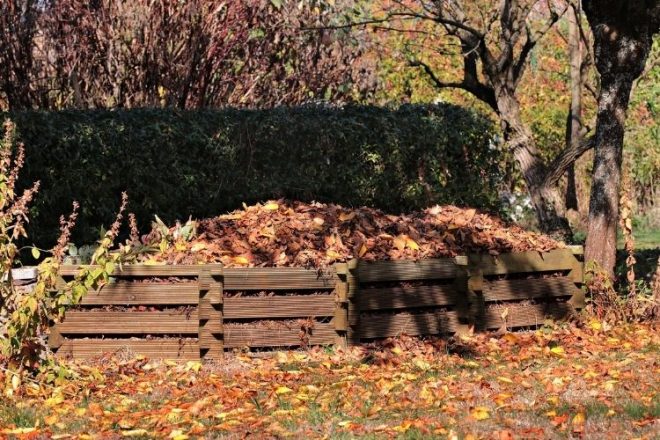Hello! At this time of year there are plenty of these.
Fallen leaves get just about everywhere – on the lawn, on beds and piled into every nook and cranny in the garden.
Rake them up however, and you’ve got a valuable supply of organic matter that can be put to excellent use for your growing.
Collected leaves can be used to make leafmold.
Leafmold is simply what you get when leaves have decomposed into dark, crumbly compost.
This decayed matter is truly gardeners’ gold and can be put to several uses in the garden – dug into the soil to improve its structure, spread on the soil surface as mulch, or used as the basis for your own potting soil mix.
Leaves from almost any deciduous tree or shrub (that’s one that sheds its leaves for winter) can be used for making leafmold, though thicker leaves such as horse chestnut can take a little longer to decompose.
Tough evergreen leaves are best added to the compost heap
where the higher temperatures will help them to break down faster, while pine needles create an acidic leafmold, so collect these separately to mulch around acid-loving plants such as blueberries.
Leaves from some trees are best avoided altogether because they release chemicals that can inhibit plant growth.
Examples include walnut, eucalyptus, camphor laurel, leylandii, and cherry laurel.
Collect leaves from anywhere in the garden – from lawns, beds and paths, plus driveways and guttering.
Leaves from heavily-trafficked roads should not be used as they may contain pollutants that could affect plant growth.
Use a rake or a leaf blower to gather your leaves into piles, then scoop them up by hand or use improvised grabbers such as these.
Alternatively, use a lawn mower fitted with a collection bag to scoop up the leaves.
Set the mower to its highest height and the blade will chop up the leaves as it collects them.
The chopped leaves will decompose quicker than whole leaves.
Leaf mold couldn’t be easier to make.
The best way is to create a leaf mold cage by securing chicken wire or mesh to four corner posts hammered firmly into the ground.
Use u-shaped nails or fence staples to hold the mesh in position, then fill with your collected leaves.
The mesh will stop the leaves from blowing away while allowing plenty of air into the leaf pile.
If the leaves are dry, wet them thoroughly after piling them in.
Check on the leaves every few months and if there are any dry patches simply turn the leaves to mix them up, then re-wet.
An even simpler solution is to stuff leaves into sturdy plastic bags.
Push the leaves right down into the bag, then tie or fold it shut at the top.
To allow air into the bag, puncture it repeatedly with a garden fork to create lots of holes.
This will also prevent the leaves from turning into a smelly mush.
Store the bags in a shady out-of-the-way corner where they will remain undisturbed.
Leafmold takes longer to make than normal compost because it relies primarily on fungal decomposition, so expect to wait around two years for perfect leaf mold.
Don’t forget, any excess leaves can always be added to your main compost heap where they will help to balance fresher green materials.
After 2-3 years your leaf mold will have a wonderfully crumbly consistency.
It’s great for enhancing your soil, feeding the soil microbes that encourage healthy root growth, improving drainage in heavier soils, and moisture retention in lighter soils.
Simply lay a thick layer on top of the soil surface then lightly fork it in, allowing the worms to do the rest of the digging-in for you.
Younger leafmold, between 1 and 2 years old, won’t be fully broken down yet but can still be put to use as a surface mulch where it will suppress weeds and work to slowly improve your soil.
Lay it 3-5 cm (1-2in) thick around fruit bushes and trees, or any well-established perennial plants.
The finest leafmold can form the basis to garden-made potting soil.
Sieve it to remove any lumps and debris then mix with weed-free garden soil or sieved compost.
Use it for growing in containers or potting on young plants.
Nothing should go to waste in the garden and fallen leaves are no exception.
We’d love to hear how you use this autumnal glut in your own garden so drop us a comment below and tell us.

